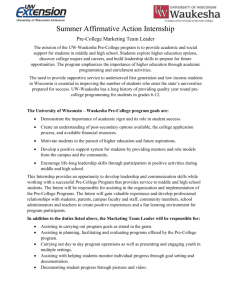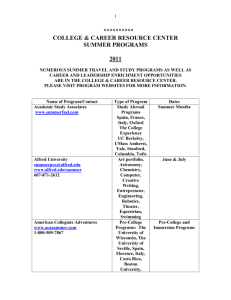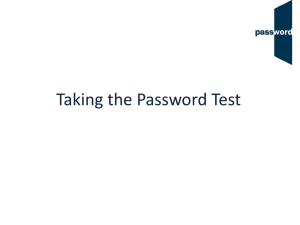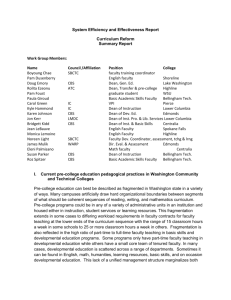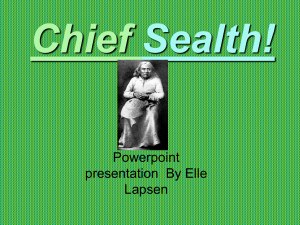Start to Finish: New Students Progress Further and Faster
advertisement
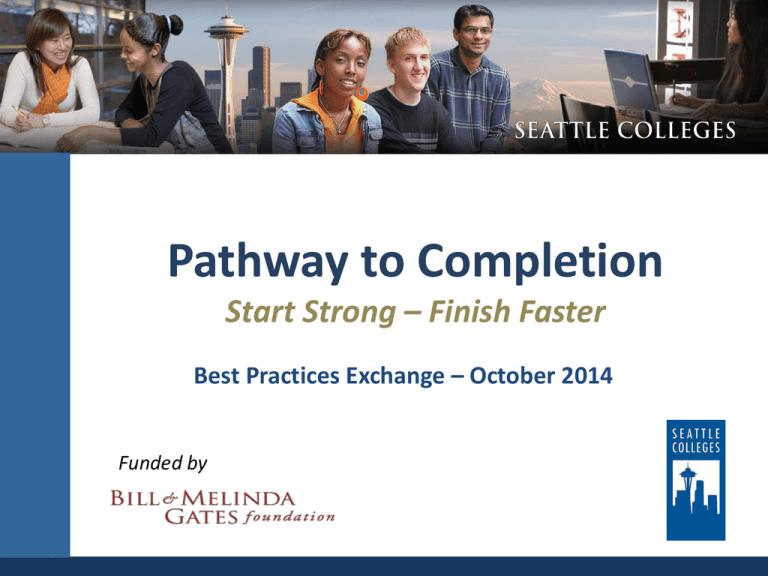
Pathway to Completion Start Strong – Finish Faster Best Practices Exchange – October 2014 Funded by Pathway to Completion Team Presenters: Carin Weiss, Vice Chancellor, Seattle Colleges Alice Melling, Associate Dean, North Seattle Paul Verschueren, Faculty Mathematics, Seattle Central Judy Reed, Associate Director, Pathway to Completion, Seattle Colleges Kim Manderbach, Dean for Student Achievement, South Seattle Jane Muhich, Lead, Math Initiatives & Productive Persistence, Seattle Central Samantha White, Data & Research Coordinator, Seattle Colleges Overview of Session Pathway to Completion Presentation Small Group Discussions ̶ ̶ ̶ ̶ Student Services Math Initiatives/Productive Persistence School Partnerships Leadership/Data Large Group Sharing About The Seattle Colleges Educate nearly 50,000 students annually Offer 135 professional-technical programs and 7 applied baccalaureate degrees Are highly diverse with 51% students of color Median student age of 29 years Challenge: Underprepared students Two-thirds referred to pre-college math ― 32% complete pre-college math in one year ― 13% in pre-college math earn credential in three years Pathway to Completion Strategy First-Year Experience Redesign Start to Finish Launched in Fall 2012 Institutional Challenges Three separately accredited colleges Variations in policy and practice Culture change needed for common and mandatory practice Start to Finish Model For Completion Strong Start Assessment Prep Multiple Placement Options Mandatory Orientation Proactive Advising Pre-College Math Acceleration Accelerated Models: Statway, Algebra Express, Self-paced modular Tracking And Student Support Advisor Dashboard Productive Persistence Educational Plan Performance Targets Pre-College Math Students Increase by 25% students who: Complete their pre-college math sequence within one year Complete their first 15 credits within one year Complete their first 30 credits within two years Complete their first required college level math course within two years Start to Finish Intentional Process for First Time Students SEATTLE COMMUNITY Start to Finish Expanded Assessment Options Online Math Refresher for Placement Test Multiple Placement Measures — Transcripts — SAT/ ACT — COMPASS Start to Finish Mandatory START Orientation for New Students Common orientation across district, offered in-person and online In-person orientation infused with advising session Target: 100% of new students First-year results: Increased participation in orientation from 18% to 97% Start to Finish Proactive Advising for Pre-College Math Students Classroom Advising – Develop educational plan; monitor student progress Educational Plan – Courses to complete program & degree Increased math sections with advisors from 3 to 34 within first year Start to Finish Advisor Dashboard – Monitoring Student Progress Tool developed in-house to create educational plans and monitor student progress Available to faculty counselors, academic advisors and students Accelerated Pre-College Math SEATTLE COMMUNITY Accelerated Pre-College Math Three models across the district Statway (Dev Algebra + Statistics) (4 quarters into 3, college level statistics) Algebra Express (3 quarters into 2) Self-paced Modular Math (1-4 quarters into 1) Accelerated Pre-College Math Scaling What Works – New Updates Statway: 59% completed pre-college and college level math in one year compared to 32% in traditional sequence Algebra Express: 53% completed pre-college math in one year compared to 32% in traditional sequence Self-Paced Modular Math: 35% of students complete two or more classes in one quarter; 14% complete sequence in one quarter Accelerated Pre-College Math Student Enrollment Total Student Enrollment 800 700 700 600 728 532 500 392 400 336 300 200 196 100 0 Fall 2012 Winter 2013 Spring 2013 Fall 2013 Winter 2014 Spring 2014 Productive Persistence A Student Success Initiative Productive Persistence The productive mindsets and effective learning strategies students need in order to be successful Tested classroom activities and interventions Practitioner and researcher partnerships Continuous learning to improve using data Productive Persistence Growth Mindsets Growth mindset: “I can learn using effort and good strategies.” Fixed mindset: “I’m not a math person.” Students with growth mindsets show increased academic performance. Social Ties Students who have doubts about their belonging withdraw at higher rates. Productive Persistence Current Projects Creating social-ties through collaborative learning Helping students set and reach reasonable goals Promoting a growth mindset in classrooms Giving students a social purpose for learning Increasing self-paced math acceleration Seattle Public Schools Partnership SEATTLE COMMUNITY COLLEGES Improving College Readiness Collaborative Work Groups resulting in: Multiple placement measures – Transcripts, SAT/ACT Transition math course for high school seniors Curriculum alignment – Intermediate algebra learning community Results and Lessons Learned SEATTLE COMMUNITY COLLEGES Start To Finish First-year Quantitative Results Performance Target: Increase by 25% students who complete their precollege math sequence within one year First Year Results: Pre-College Math Completions 50% 40% 44% 39% 32% 30% 20% 10% 0% Baseline 2007-10 Year 1 of Grant 2012-13 Accelerated Math (to date) Start To Finish First-year Quantitative Results Performance Target: Increase by 25% students who complete their first 15 credits within one year First Year Results: 13% increase in completion of first 15 credits within one year Second Year Results: 19% increase in completion of first 15 credits within one year Students starting in summer or fall 2013 Number of Students Impacted to date In total, 13,855 students impacted by completion initiative Lessons Learned for Success and Scaling Leadership and Engagement-- Top leadership commitment, college leads, faculty and staff teams Assessing What Works-- Data are complex and require advanced research methods District Coordination-- Align processes, ongoing sharing and scaling of internal best practices, external and internal standardized communication materials
